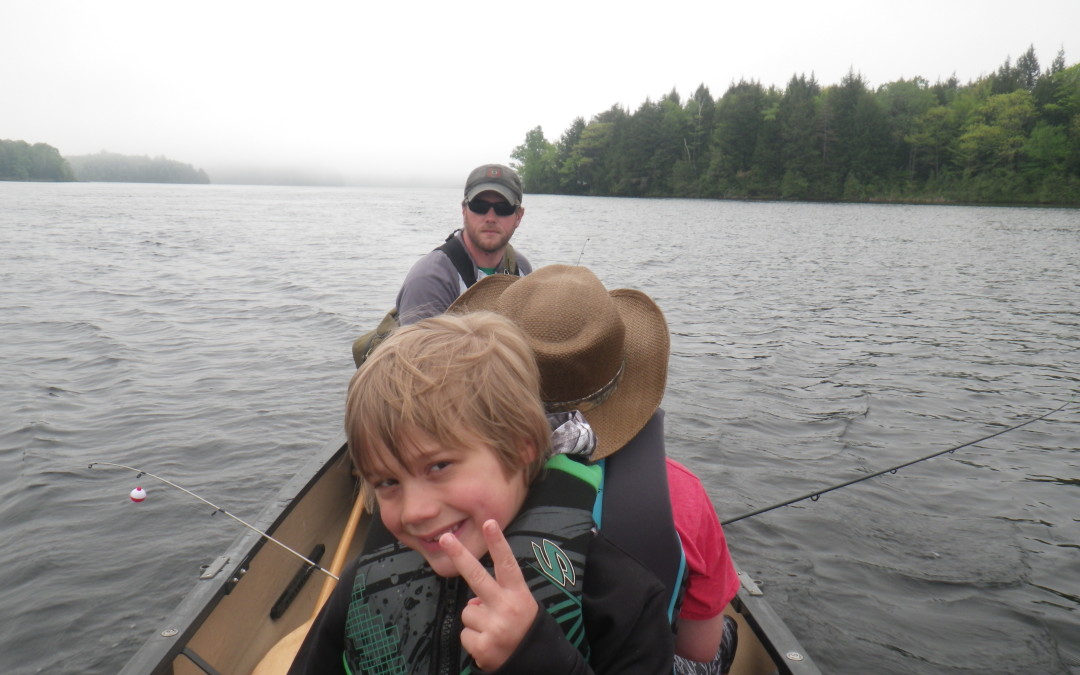“How will I know when a fish takes my lure?” This is the most common question that I am asked when an angler trolls for the first time. When a fish takes your streamer or lure there is no question as the rod bounces rapidly. I just think back to when I first began trolling and I think the most exciting aspect of this technique is the anticipation. Trolling is the practice of motoring or paddling with lines behind you and waiting for a fish to grab your offering. Many times the fish hooks itself and all you need to do is reel the fish in. It is not as easy as it sounds and does take practice, time and a lot of patience. Speed, length of leader, weather conditions and having the proper lure or streamer are only a few variables that factor into this type of fishing. Add in a seven and eleven year old and the questions keep coming. I just smile and say “trust me, you will know.”
This past weekend I took my brother and two of my nephews out trolling on one of my favorite rivers. This river is full of salmon with a liberal bag limit for those that want to take some fish home. The main reason for this special regulation is that the biologists want anglers to take fish home to increase the size and quality of the remaining fish. Each body of water, or even area of land, has a carrying capacity. This means that there is only so much food and available space for a set limit of animals or fish to be able to live and thrive. If there are too many fish in a body of water then they will not grow to their potential and will remain stunted. For animals such as deer the side effect of being over the carrying capacity is disease, starvation and ultimately death. What I can tell you is that this regulation seems to be working on this river as the majority of the fish I catch here are well over 14 inches. There are also prolific hatches that the salmon frequently rise to even in heavy current. Even with the surface activity the salmon are very willing to take streamers and lures as well. While we were there the caddis and Hendricksons were coming off very thick, but even with the plethora of surface activity the salmon seemingly rise without rhyme or reason.
As we got underway I got Alex set up with my trolling fly rod with a Grey Ghost Special that had worked the day before and I was confident in. Matt was setting Bennet up with a new spinning rod that he had purchased for him the day before. It is always vitally important to know the limitations of the equipment that you use and I did not check whether this rod and reel would be able to handle the stress of catching and landing a salmon in a strong current. Well we found out rather quickly as a strong salmon grabbed the lure and I heard a crack and saw the reel come off the rod base. Quick action from Matt prevented the reel from going over the side of the canoe, but needless to say we lost the fish. We then got Bennet set up with a reliable rod and reel. The action was quick to pick up again and all thoughts of losing that first fish were forgotten. That is always good when you have young anglers in the boat. Also I will never forget the look on Alex’s face when he had a fish hit his streamer the first time. All I could say was “I told you that you would know when you had a fish.” If your target species does not work out, have a secondary plan that will keep their attention. That is also vitally important when it comes to lunch time. Have something tasty, easy and quick or you will end up with two youngsters throwing rocks into the river and getting into mischief. I keep forgetting how my brother and I were when we were young and we would have been doing the same.
The afternoon was not as fast fishing as the morning, but enough to keep the boys entertained. Once back on the water we focused on the lower part of the river and into the lake. As an experiment after Matt lost a nice salmon at the side of the canoe I put a lure in the prop wash of my motor no more than thirty feet behind us. It was barely five minutes and I had a feisty salmon on the end of my line. Never be scared to try something different or experiment as you never know the outcome. My only piece of advice is to make sure you know that the fish are there and that they have been active, that way you will have a baseline to work with. If the fish have not been biting then you are really just grasping at straws hoping for a better outcome.
On Monday I brought Frank and Cindy out on a smaller stream that holds some very nice salmon and brook trout. The flows were very strong and I had to be careful as to where I placed them so not to put them in a dangerous situation. Frank was quickly into some nice brook trout with his Fox Hole Streamer, but Cindy was having fish follow her fly without any takers. To change things up I had Cindy cast into a back eddy closer to the dam. I tied on a baby Brook Trout streamer to her line as my thinking was any larger trout and salmon would recognize this as prey given their cannibalistic nature. While talking with Frank I heard Cindy yell my name and when I turned around I saw her rod bent over with a large fish on the other end. I quickly got next to her to get into position to net her fish. I began to think this was a large brook trout as it stayed down and never came to the surface. When it finally came to the surface I was shocked as this was largest salmon I had ever seen come out of this stream and was easily 3.5 to 4 pounds. I briefly had a chance to net this behemoth that was unsuccessful and Cindy did a great job fighting this fish. However, he had other plans and made a quick head shake and was gone. All I could do was give Cindy a hug and let her know she did nothing wrong.
We moved to the middle section of the stream, which is much easier wading even with the heavier flows in the afternoon. The rain had moved out and we were treated to sunny blue skies. Many trout started to rise sporadically on the surface giving us easier targets to cast to. I switched Frank to a Maple Syrup, which can indicate many different things and is a traditional Maine pattern. This pattern worked well and Frank was into a brook trout in no time. For Cindy I tied on a Blue Winged Olive RS2 emerger. This has been a go to pattern for me throughout the state and you can use it in many different applications. Whether as a dropper or swung on a tight line through current this produced in many challenging situations. The trick is to make sure that your fly swings on a tight line and does not create a bow that speeds up your fly too quickly. Even after your fly has made the full swing let it hang in the current and many times trout and salmon will grab it. This was exactly how our day ended. Cindy was moving to a better casting position and her streamer was simply holding in some fast water when a trout came up and grabbed it. Never a bad way to end a day on the water.

You know it was a good day when the paint has been chipped off your lures from catching so many fish












